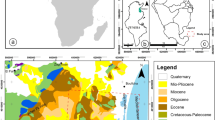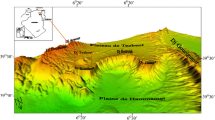Abstract
Photogeological, geoelectrical, and drill-hole data were used to determine the hydrogeological conditions of the regolith layer mantling the Precambrian rocks in the northern Obudu plateau of southern Nigeria. The regolith thickness is 3.8–89.5 m (mean 38 m). Water for domestic purposes is extracted by dug wells <15 m deep and shallow boreholes <50 m. The mean value for permeability of the saturated regolith is 7.5×10−1 m/d and for transmissivity, 3.8×10−1 m2/d. The regolith wells have a high specific capacity, 40–270 m3/d/m and a high yield, 700–4,050 m3/d. Using statistical analysis, well yields and specific capacities can be estimated if the saturated thickness and apparent resistivity of regolith layers are known from drill-hole data and vertical electrical sounding. Chemical data show that the major groundwater types are calcium-bicarbonate (Ca-HCO3) and sodium+potassium bicarbonate [(Na+K)-HCO3] and the water quality meets national and international standards for drinking, domestic and agricultural purposes. However, for future proper management of water resources in the area, care should be taken, that waste-disposal sites for both solid and human waste should not be located near waste sources.
Résumé
Des données photogéologiques, géoélectriques et de forage ont été utilisées afin de déterminer les conditions hydrogéologiques de l’aquifère régolithique qui recouvre les roches précambriennes dans le plateau nord d’Obudu au sud du Nigeria. L’épaisseur de régolithe varie entre 3.8 et 89.5 m avec une moyenne de 38 m. L’eau destinée aux usages domestiques est extraite de puits de surface (< 15 m de profondeur) et de puits artésiens (< 50 m). La valeur moyenne de perméabilité du régolithe saturé est de 7.5×10−1 m/j et la transmissivité moyenne de 3.8×10−1 m2/j. Les puits qui exploitent l’aquifère de régolithe ont une capacité spécifique variant entre 40 et 270 m2/j/m et un rendement élevé de 700 à 4 500 m3/j. Avec l’aide d’une analyse statistique, le rendement et la capacité spécifique des puits peuvent être estimés si l’épaisseur saturée et la résistivité apparente des couches de régolithe sont déterminées avec des forages et des relevés électriques verticaux. Des données sur la composition chimique de l’eau montrent que les types d’eau majeurs sont bicarbonaté-calcique et bicarbonaté sodique + potassique et que la qualité de l’eau rencontre les standards nationaux et internationaux pour l’eau potable, l’utilisation domestique et à fins d’agriculture. Malgré tout, dans l’optique d’une gestion appropriée des ressources en eau dans la région, une attention particulière doit être portée aux sites d’enfouissement des déchets solides et humains qui ne devraient pas être localisés près des sources d’eau.
Resumen
Se utilizaron datos fotogeológicos, geoeléctricas y de barrenación para determinar las condiciones hidrogeológicas de la capa de regolito que cubre rocas precámbricas en la meseta obudu septentrional del sur de Nigeria. El regolito tiene un espesor de 3.8–89.5 m (promedio38m). El agua para uso doméstico se extrae medio de pozos excavados hasta profundidades de 15 metros y por barrenos no muy profundos de 50 metros. La permeabilidad promedio del regolito saturado es 7.5×10−1 m/d, con transmisibilidad de 3.8×10−1 m2/d. Los pozos dentro del regolito tienen alta capacidad específica de 40–270 mm2/d/m y un alto rendimiento de 700–4,050 mm3/d. Se puede estimar el rendimiento de los pozos y capacidades específicas usando análisis estadístico si el espesor saturado y la resistividad aparente de las capas de regolito se conocen a partir de los datos de barrenación y sondeo geoeléctrico. Los datos químicos muestran que los tipos de aguas subterráneas son principalmente de bicarbonato de calcio (Ca-HCO3) y bicarbonato de sodio y potasio [(Na+K)-HCO3] y el agua cumple las estándares de calidad nacional y internacional para agua potable y para uso doméstico y agrícola. Sin embargo para el futuro manejo apropriado del recurso de agua en el área es importante que se tenga cuidado de que los sitios de desechos de basura solida y humana no sean ubicados cerca de los fuentes de agua.
















Similar content being viewed by others
References
Appello CAJ. Potsma D (1993) Geochemistry. groundwater and pollution. 2nd edn.. Balkema. Rotterdam.
Brown CE (1998) Applied multivariate statistics in geohydrology and related sciences. 1st edn.. Springer. Heidelberg Berlin New York.
Chilton PJ. Foster SD (1995) Hydrogeological characterization and water supply potential of basement aquifers in tropical Africa. Hydrogeology Journal 3(1):36–49
Cratchley CR (1958) Memorandum of water supplies of Kankara town and district. Katsina Province. Report Geological Survey of Nigeria. 7 pp
Davis JC (1986) Statistics and data analysis in Geology. 2nd edn.. John Wiley and Sons. New York
Edet AE (1993) Hydrogeology of parts of Cross River State. Nigeria: evidence from aerogeological and surface resistivity studies. PhD Dissertation. University of Calabar. Nigeria.
Edet AE. Teme SC. Okereke CS. Esu EO (1994) Lineament analysis for groundwater exploration in the Precambrian Oban massif and Obudu plateau. SE Nigeria. Journal of Mining and Geology 30:87–95
Edet AE. Teme SC. Okereke CS. Esu EO (1998) Application of remote sensing data to groundwater exploration: a case study of the Cross River state. southeastern Nigeria. Hydrogeology Journal 6:394–404
Ekwueme BN (1991). Geology of the area around Obudu cattle ranch. southeastern Nigeria. Journal of Mining and Geology 29:277–282
Ekwueme BN (1994). Basaltic magma related to early stages of rifting along the Benue trough: the Obudu dolerites of southeastern Nigeria. Geological Journal 29:269–276
Ekwueme BN (1998) Geochemistry of Precambrian gneisses of Obudu plateau. southeastern Nigeria. Global journal of Pure and Applied Sciences 4(3):277–282
Freeze RA. Cherry JA (1979) Groundwater. 2nd edn. Prentice Hall Englewood Cliffs. New Jersey. USA.
Gascoyne M. Kamineni DC (1994) The hydrochemistry of plutonic rocks in the Canadian Shield. Applied Hydrogeology 2(2):43–49.
Gascoyne M. Ross JD. Watson RL. Kamineni DC (1989). Soluble salt in a Canadian Shield granitie as contributors to groundwater salinity. In Proceedings Water-Rock Interaction Symposium. Malvern. UK 247–247
Gibbs RJ (1970) Mechanisms controlling world water chemistry. Science 170:1.088–1.090
Greenbaum DC (1985). Review of remote sensing applications to groundwater exploration in basement and regolith. British Geological Survey. BGS Report OD 85/8 36 pp
Kamineni DC (1987). Halogen-bearing minerals in plutonic rocks: a possible source of chlorine in saline groundwater in the Canadian Shield. In Fritz P. Frappe SK (eds):69–80
Levinson AA (1974) Introduction to exploration geochemistry. Applied Pub. Company Calgary. Canada.
Lloyd JW. Heathcote JA (1985) Natural inorganic hydrochemistry in relation to groundwater: An introduction. Clarendon Press. Oxford. England.
Niwas S. Singhal DC (1981). Estimation of aquifer transmissivity from Dar-Zarrouck parameters in porous media. Journal of hydrology 50:393–399
Nkotagu H (1996). The groundwater geochemistry in a semi arid fractured crystalline basement area of Dodoma. Tanzania. Journal of African Earth Sciences 23(4):593–605
Olorunfemi MO (1990) The hydrogeological implication of topographic variation with overburden thickness in basement complex area of SW Nigeria. Journal of Mining and Geology 26(1):145–152
Omorinbola EO (1982) Verification of geohydrological implications of deep weathering in the basement complex of Nigeria. Journal of Hydrology 56:347–368
Tardy Y (1971). Characterization of principal weathering types by the geochemistry of waters from some European and African crystalline massifs. Chemical Geology 7:253–271
Umeji AC. Fitch CA (1988) The Precambrian of southeastern Nigeria: a magmatic and tectonic study. Geological Survey of Nigeria Report 12 pp
World Health Organisation (WHO) (1984) Guidelines for drinking water quality. Vol 1 Recommendations Geneva. Switzerland
Wright EP (1992). The hydrogeology of crystalline basement aquifers in Africa. In Wright EP. Burgress WG (edns). Hydrogeology of crystalline basement aquifers. Geological Society Special Publication 66:1–27
Zohdy AAR. Eaton GP. Mabey DR (1994). Application of surface geophysics to groundwater investigations. United States Geological Survey Book 2 Chapter D1. 116 pp
Acknowledgements
The authors are grateful to Sigma Xi. the Scientific Research Society. USA and to the University of Calabar. Nigeria for providing research grants during the period of study. The German Academic Exchange Servive (DAAD). Bonn is acknowledged for providing field equipment. We are grateful to four anonymous reviewers for critically reviewing this article.
Author information
Authors and Affiliations
Corresponding author
Rights and permissions
About this article
Cite this article
Edet, A., Okereke, C. Hydrogeological and hydrochemical character of the regolith aquifer, northern Obudu Plateau, southern Nigeria. Hydrogeol J 13, 391–415 (2005). https://doi.org/10.1007/s10040-004-0358-9
Received:
Accepted:
Published:
Issue Date:
DOI: https://doi.org/10.1007/s10040-004-0358-9




